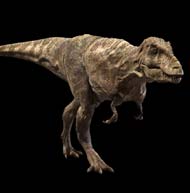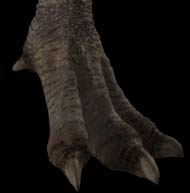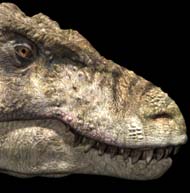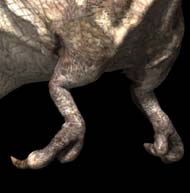|
Български - English
|
Tarbosaurus At a lofty five metres tall and a whopping five tonnes in weight, Tarbosaurus was monstrously large. But Tarbosaurus was relatively light on its feet, despite its size. It probably used its long, powerful legs to sprint across the Mongolian desert after prey.
At a lofty five metres tall and a whopping five tonnes in weight, Tarbosaurus was monstrously large. But Tarbosaurus was relatively light on its feet, despite its size. It probably used its long, powerful legs to sprint across the Mongolian desert after prey.
There were not many dinosaurs around at the time capable of taking on Tarbosaurus. The dinosaur may have stalked the lightly wooded areas on the desert outskirts, searching for vulnerable, lone dinosaurs or lying in wait for other animals to approach it. Once a suitable victim had been spotted, Tarbosaurus would have made an explosive run for its prey. The dinosaur may have tried to exhaust its prey before using its powerful jaws to sink its sharp teeth into the other animal. Tarbosaurus' victims could at least take comfort in the knowledge that death would be swift. Tarbosaurus would then dissect the corpse, removing as much meat as possible before leaving the body to other scavengers. Tarbosaurus may have hunted dinosaurs that were almost as large as itself (such as Saurolophus) although gigantic dinosaurs such as Therizinosaurus may have been too large for it to handle. The metabolism of Tarbosaurus means that it probably only needed to eat once every two or three weeks although, like any animal, it would have taken advantage of any opportunity that came its way. Tarbosaurus had a good sense of smell, which may have played a role in locating its food or in detecting the scent of a rival or potential mate. It may have roamed over a moderately wide area in search of food or a sexual partner. Like, Tyrannosaurus, its American cousin, Tarbosaurus would have been a dinosaur to avoid in the Mongolian Late Cretaceous.
|
Български - English
|
www.bbc.co.uk - www.enchantedlearning.com - www.dinosauria.com - www.ucmp.berkeley.edu - www.cbv.ns.ca - http://pubs.usgs.gov
| © 2004 - 2005 Blagomir Ivanov. All rights reserved. |


